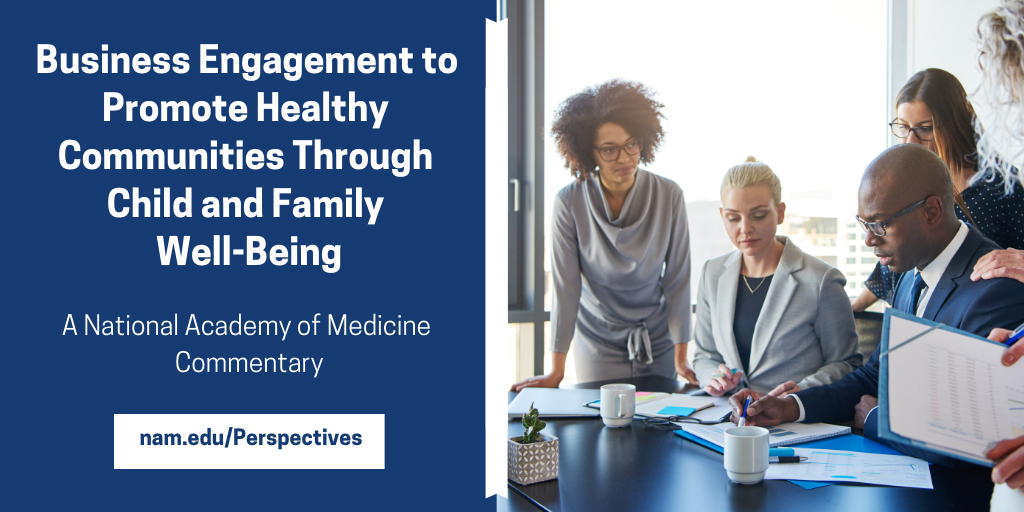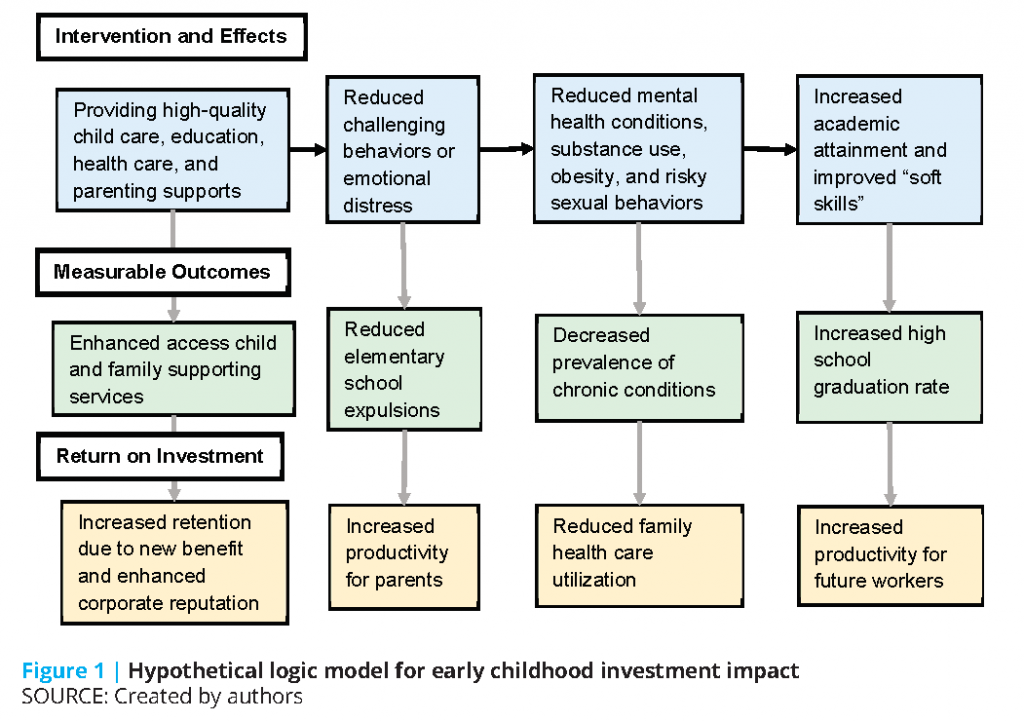Business Engagement to Promote Healthy Communities Through Child and Family Well-Being


Why does business care about child and family well-being to promote community health?
Traditionally, businesses invest in projects to help children and families out of a sense of philanthropy or charity. But, they are increasingly realizing that building a better future workforce is a core business strategy that is essential to the well-being of companies and their communities [1]. Companies are speaking out about the need to give children a good start on the path to a productive adulthood for a wide variety of reasons related to their own success: the productivity of the current workforce; preparedness of the future workforce; management of health care costs (whether self-insured or not); creation of a productive citizenry who can afford to buy the companies’ goods and services; improvement of the business climate in the community in order to attract the best workers; maximization of the efficient use of public dollars; and encouragement of employees to think of the business as a great place to work [2]. In keeping with the U.S. Surgeon General’s call to engage business in promoting community health, this paper serves as a resource for scholars, health professionals, community leaders, and their prospective business partners.
Business involvement in supporting community health is critical because, sadly, too many children and youth are not on track to become healthy, productive adults. The World Bank’s Human Capital Index found that on average, “A child born in the United States today will be 76 percent as productive when she grows up as she could be if she enjoyed complete education and full health” [3]. This stems from a range of problems facing children and families, including toxic stress from poverty or violence, obesity, mental health conditions, or substance abuse. Fortunately, there are effective prevention programs and interventions to address these and other problems. Yet, too few communities enjoy sustained investment in effective programs that engage families in promoting healthy development for children, and these same children are not being set up for the academic attainment or social and emotional skills needed to thrive in the workplace. Evidence-based investments—particularly in early childhood—could promote healthier communities and be good for business. Businesses, with their operational efficiency and community relationships, are well-positioned to lead the way in ensuring that communities implement the foundational, evidence-based programs and policies that families need.
How can business contribute to child and family well-being to promote community health?
An array of studies from the United States and around the world demonstrate that giving children a good start with quality early education, health, nutrition, and parental supports can substantially affect adult outcomes in health, education, and employment [4]. Because parents or other caregivers are children’s first and most important nurturers, many effective programs target two or more generations. Evidence-based programs can have a profound impact on community well-being and influence whether adults become part of the civic fabric that supports community life [5].
Because of the relationship between early childhood experience and life course health and adult productivity, businesses around the world—from small to multinational companies—have started to take actions to provide this good foundation. For companies interested in making these investments, the Robert Wood Johnson Foundation’s County Health Rankings summarize the factors and opportunities for improving community health, including investing in children and families. Businesses should work with local experts to assess which actions would be most effective at improving child and family well-being in their community. Local health experts and scholars know their community and can bring science to bear on problems facing children and families. Employees may have contact with appropriate experts or the state’s maternal and child health program (given a slightly different name in each state) could provide a potential contact. Once identified, the local children’s health expert will know what targets might have widespread effects and therefore be wise investments for local businesses. Local health experts can also help businesses understand what the short- and long-term outcomes of an intervention could be, how these could be measured, and what this could mean for return on investment (ROI), so that businesses can better support the success of their investment.
Based on the local needs and opportunities identified, businesses can take a variety of actions that use their diverse assets. ReadyNation has seen businesses successfully take action across a wide spectrum [6], such as:
- Investing in promising community programs through funds, employee volunteer time, expertise, etc.
- Supporting employees with family-friendly and healthy promotion and benefits policies, including providing health insurance coverage of effective family-focused services and information on healthy habits.
- Communicating about the importance of child and family well-being through customer and supply chains. For example, Boots, an optical and pharmacy chain in the United Kingdom, developed a free children’s book that customers can use to look for eye problems with their young children.
- Promoting social entrepreneurship initiatives that make a profit while also contributing to a social good. A wonderful example is the co-location of child care centers and elder care homes, which benefits both generations and helps both organizations stand out in the marketplace, as in the Providence Mount St. Vincent facility in Seattle.
- Using their position as community leaders to communicate to the media and other leaders about the importance of investing in child and family well-being. For example, a Cushman & Wakefield executive co-authored an op-ed in Memphis’ Commercial Appeal in support of early education.
- Advocating for policy change at the local, state, and national levels. Importantly, business members of ReadyNation were a strong voice that helped win renewal of the federal Children’s Health Insurance Program, child care subsidies, and federal home visiting funds in 2018, including a national sign-on letter with 50 executives in support of home visiting.
Many businesses promote child and family well-being through health benefits that ensure a two-generation approach and/or through support for high-quality child care and early education. For a better understanding of the potential ROI, the authors of this paper developed a framework for thinking through how these few examples of investment could play out:
This framework could be helpful in understanding how a chosen action may result in different measurable outcomes at different points in time. While the specific effects will differ for each intervention and community context, local health and education experts can help businesses understand the anticipated impact of the interventions and engage as partners. At least some of these measurable outcomes and ROIs will likely be attainable through early childhood investments [3] feasible for a given business, and the ROI can promote a sustainable strategy of early childhood investment. Based on the different time frames over which outcomes and related ROIs are realized (the soonest being on the left and the furthest on the right), businesses also have the opportunity to evaluate over time how investments are playing out.
What partners do businesses need?
Additional work is needed to support businesses as leaders in children’s health. A recent discussion hosted by the National Academies of Sciences, Engineering, and Medicine’s Forum for Children’s Well-Being with business (and health insurance) leaders highlighted some key issues that will require attention in order to strengthen future business investment.
- Incentives, investments, and savings (ROIs) still often remain in silos. As a result, business investment in healthy children and families can result in savings across sectors in the community (e.g., health, education, policing, etc.) that are difficult to measure. Even more difficult to measure are the life course health benefits of investing in children and families, where savings are seen downstream in the future health and productivity of adults, not necessarily still in the same community.
- Businesses need easy access to evidence. The academic community will need to develop metrics for outcomes that are meaningful for business (e.g., child and family health, employer impacts), particularly those resulting from health promotion and prevention programs. Effective messaging is critical, and there remains an important role for “knowledge brokers” to translate science effectively with business communities. It is hard to overestimate how much the academic community may need to “boil down” reports and data and streamline communication processes to fit into business executives’ packed schedules.
Conclusion
Businesses can lead the nation in securing the necessary investment in the healthy development of children and families. Their leadership is needed to ensure that every community has the foundation of evidence-based family supports for producing the workforce of tomorrow. Businesses have a range of steps they can take to promote effective investments in healthy development locally or nationally, and scholars, knowledge brokers, and policy professionals should continue to design tools to support these efforts so that the next generation—and businesses—can thrive.
Join the conversation!
![]() Tweet this! New from @theNAMedicine: Business Engagement to Promote Healthy Communities Through Child and Family Well-Being: https://doi.org/10.31478/201812c #NAMPerspectives
Tweet this! New from @theNAMedicine: Business Engagement to Promote Healthy Communities Through Child and Family Well-Being: https://doi.org/10.31478/201812c #NAMPerspectives
![]() Tweet this! Businesses can significantly bolster efforts to promote the well-being of children and families. Authors explain why this is a smart investment: https://doi.org/10.31478/201812c #NAMPerspectives
Tweet this! Businesses can significantly bolster efforts to promote the well-being of children and families. Authors explain why this is a smart investment: https://doi.org/10.31478/201812c #NAMPerspectives
![]() Tweet this! Businesses should support efforts to improve the well-being of children and families, but should partner with local experts to ensure that their investment is most effective: https://doi.org/10.31478/201812c #NAMPerspectives
Tweet this! Businesses should support efforts to improve the well-being of children and families, but should partner with local experts to ensure that their investment is most effective: https://doi.org/10.31478/201812c #NAMPerspectives
![]() Tweet this! To ensure continued business investment in programs to support child and family well-being, we must ensure that the ROI is clear: https://doi.org/10.31478/201812c #NAMPerspectives
Tweet this! To ensure continued business investment in programs to support child and family well-being, we must ensure that the ROI is clear: https://doi.org/10.31478/201812c #NAMPerspectives
Download the graphics below and share them on social media!



References
- Zellner, S., and L. Bowdish. 2017. The ROI of health and well-being: Business investment in healthier communities. NAM Perspectives. Discussion Paper, National Academy of Medicine, Washington, DC. https://doi.org/10.31478/201711b
- ReadyNation. 2017. A healthy bottom line. Available at: https://www.strongnation.org/articles/439-a-healthy-bottom-line (accessed September 29, 2018).
- World Bank Group. October 2018. United States: Human Capital Index 24 out of 157. Human Capital Index: Country Briefs and Data. Washington, DC: World Bank Group. Available at: http://databank.worldbank.org/data/download/hci/HCI_2pager_USA.pdf (accessed November 16, 2018).
- Heckman, J. J. 2007. The economics, technology, and neuroscience of human capability formation. Proceedings of the National Academy of Sciences 104(33):13250–13255. https://doi.org/10.1073/pnas.0701362104
- Hoagwood, K. E., M. J. Rotheram-Borus, M. A. McCabe, N. Counts, H. M. E. Belcher, D. K. Walker, and K. A. Johnson. 2018. The interdependence of families, communities, and children’s health: Public investments that strengthen families and communities, and promote children’s healthy development and societal prosperity. NAM Perspectives. Discussion Paper, National Academy of Medicine, Washington, DC. https://doi.org/10.31478/201804a
- ReadyNation. 2016. How your company can help parents engage with their young children. Washington, DC: ReadyNation. Available at: https://www.strongnation.org/articles/113-how-your-company-can-help-parents-engage-with-their-children (accessed October 18, 2018).

